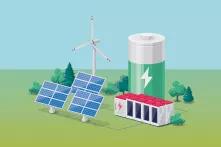The European Commission has unveiled its new strategy to make EU industries more competitive with cheap energy. Does this mean the bloc will go full speed ahead in terms of building more wind farms and solar power plants? Jörg Mühlenhoff looks into what the details of the Clean Industrial Deal mean for Europe’s energy transition.

In the summer of 2024, when Ursula von der Leyen presented her first plans for her second mandate in charge of the European Commission, many observers wondered whether her Clean Industrial Deal would become the political ‘assassin’ of the previous European Green Deal or rather its offspring. The Clean Industrial Deal was published as one of the new flagship projects during the first 100 days of von der Leyen’s new term on 26 February 2025. And it still builds to a large extent on the objectives of its predecessor, so we can therefore call it its child. Parents, however, know that their children often want to take their distance and mark their identity by going in exactly the opposite direction of the one expected from them. That means a number of risks that we identified for the European Green Deal could materialise.
First of all, the scope of the Clean Industrial Deal is not very clear. It neither names the key industries nor defines what is ‘clean’, but establishes ‘technology neutrality’ as the main rule. Under such randomness, the EU will fail in prioritising the technologies of the future that it needs for boosting its competitiveness. The Clean Industrial Deal lists measures for six ‘business drivers’ (affordable energy, lead markets, investments, circular economy, global partnerships and skills). Although renewable energy technologies are mentioned explicitly across most of these drivers, the Clean Industrial Deal caters for a broad, almost eclectic range of industries and energy carriers. As a matter of fact, the proposals are not necessarily tailored to the specific needs of the EU’s energy transition.
It is good to see that a new Clean Industrial Deal State Aid Framework might simplify financial support to renewables. Besides that, the Clean Industrial Deal does not suggest any brand-new initiatives or legislative proposals that aim explicitly at accelerating the growth of renewable energy installations in the EU. Although not focussing on the challenges of a renewable energy system, it tackles some of its main hurdles.
The successful EU rules for speeding up permitting of some renewable energy technologies are to be expanded; thus, they will potentially simplify the roll-out of more renewable energy installations on the ground. The Clean Industrial Deal suggests expanding these rules on faster permitting beyond renewables to energy infrastructure and storage projects (as well as to industrial decarbonisation projects). This is promising because delays in grid expansion and connection hamper the use of cheap renewable electricity in many Member States.
Bottlenecks in grids as a main hurdle will also be tackled with the announced European Grid Package and the Grids Manufacturing Package. The Clean Industrial Deal consistently tries to trigger demand-side flexibility to ease existing energy infrastructure, announcing guidance and recommendations. However, any detailed plans on how to prepare energy networks and their users for a renewable energy system are missing at this moment.
It is deceiving that the references to the energy demand side remain weak. The Clean Industrial Deal does not refer to energy savings explicitly. Its Action Plan for Affordable Energy only mentions vague plans to explore a guarantee scheme for investments into energy efficiency. In contrast with existing EU legislation and the European Green Deal, it basically ignores the ‘energy efficiency first’ principle. Although it features prominently the term ‘circular economy’, the Commission uses it as a very large umbrella that potentially also entails a questionable technology such as carbon capture and usage in the sense of ‘recycling carbon’. This could open the door for a continued use of fossil fuels.
The Clean Industrial Deal still sticks to dirty energies
While correctly describing the costly fossil fuel imports as the biggest threat to EU industries’ competitiveness, any phase-out trajectories for coal, gas and oil are missing. The Clean Industrial Deal even promotes increased liquefied natural gas (LNG) imports under Action 3 of the Action Plan for Affordable Energy, for the purpose of ‘[e]nsuring well-functioning gas markets’. It plans to explore direct EU investments in LNG export infrastructure in third countries – maybe in a move to please the new Trump administration. Such a strategy deepens EU industries’ fossil fuel dependency and increases its import bill. The Clean Industrial Deal, in fact, would undermine the competitiveness that it wants to boost. The Roadmap towards ending Russian energy imports, initially announced with the Clean Industrial Deal, has been postponed.
The ‘technology neutrality’ dogma irradiates the Clean Industrial Deal, as in contrast with the European Green Deal, it bets on another old and costly option, namely nuclear energy. The proposals to assess state aid for nuclear technology and to accelerate the deployment of small modular reactors weaken the European Green Deal focus on renewable energy.
Nuclear fusion energy is far from being a proven and mature technology. It is completely misplaced to consider it in a dedicated strategy in view of any investments for market introduction, let alone for reducing electricity costs. And even the most optimistic pro-nuclear advocates will admit that small modular reactors (SMRs) will not feed meaningful quantities of electricity into EU electricity grids before the 2040s. It is rather unrealistic to expect that the levelised costs of electricity generation from SMRs and other new reactors will ever get close to solar and wind power. Building new reactors of whatever size takes at least one to two decades. So why does the Action Plan for Affordable Energy, a plan that ‘presents measures to lower energy bills in the short term’, make licencing practices for new nuclear technologies and SMRs a priority?
Will the Clean Industrial Deal be in line with ambitious climate policies?
As a signatory of the Paris Agreement, the European Commission’s emission reduction target for 2040 has been due since last year. However, the Commission again postponed the initially announced 2040 climate target. The Clean Industrial Deal formally commits to net-zero emissions by 2050 and the 2040 target of 90% net greenhouse gas emissions reduction. But is this more than just lip service? The Clean Industrial Deal misses the chance for a consistent emissions reductions strategy, for instance by setting sector-specific renewable energy targets for the energy-intensive industries.
A missed opportunity for fair participation in Europe’s energy transition?
Last but not least, the Clean Industrial Deal might lead to conflicts about its distributive justice. The Commission’s proposals suggest a number of measures that mainly target the established big industrial energy consumers. Public guarantees for long-term contracts that channel cheap renewable electricity to those industries will likely be a win-win for improving both industries’ competitiveness and renewable project developers’ investment security. But ordinary households and small and medium-sized enterprises (SMEs) will probably lose out. Such long-term contracts are not yet accessible to such small consumers. The allocation of costs and benefits of these contracts needs to be discussed and should not lead to higher retail electricity prices for non-industrial consumers. If energy-intensive industries are exempted from paying taxes and infrastructure costs, the burden must not then just be shifted to households and SMEs.
The EU should not undermine the social acceptance of the EU’s energy transition. The Action Plan for Affordable Energy announces EU guidance on network tariffs, on incentives for demand response and on taxation during the next months. Civil society and the renewables industry, together with the European Parliament, should use this opportunity to ensure that citizens can benefit better from the EU’s energy transition. There are many more tools that will allow households and SMEs to cut their bills, such as energy sharing, block tariffs for a cheap and clean basic energy supply, or targeted support for building renovation. Without fair participation, the Clean Industrial Deal could be perceived as another elitist project for the incumbents. The additional Citizen Energy Package announced by the European Commission for the second half of 2025 will need to make sure that the Clean Industrial Deal does not ignore ordinary households’ needs.


